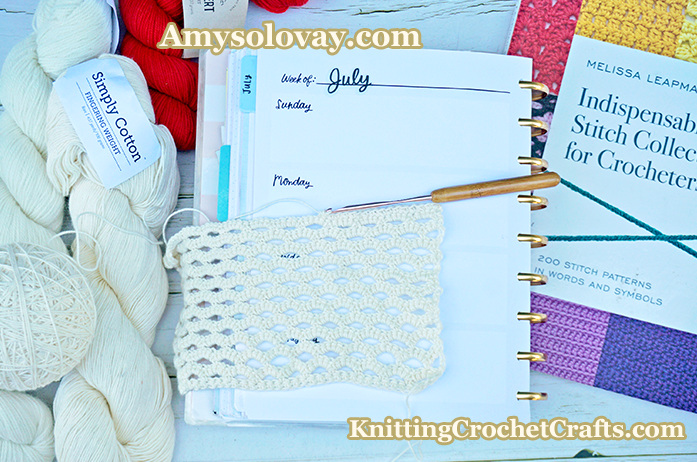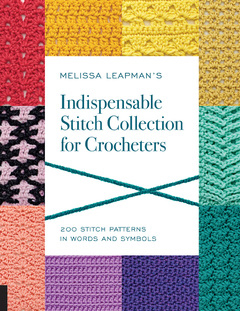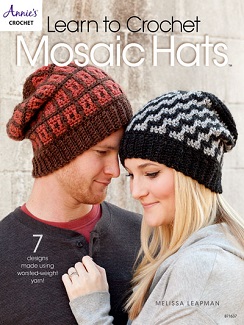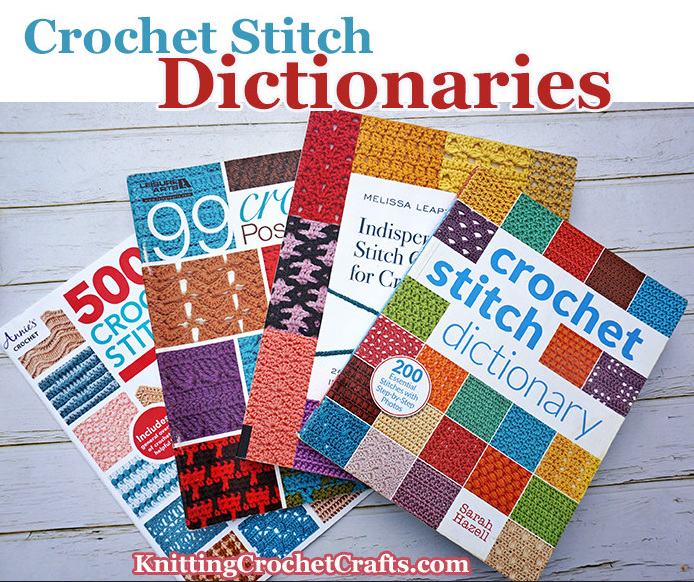Melissa Leapman’s Indispensable Stitch Collection for Crocheters: 200 Stitch Patterns in Words and Symbols

Would you enjoy having easy-to-follow charted out and written instructions for bunches of different crochet stitches including…
- Shell stitches
- Crochet lace stitches
- Cables
- Braids
- Post stitches
- Basketweave designs
- Colorwork patterns
- Popcorn stitches
- Edgings
- and more?
If so, you’re going to want to check out Melissa Leapman’s Indispensable Stitch Collection for Crocheters.
There are overwhelming numbers of crochet instruction manuals available. What sets this one apart from all the others: It’s a collection of the 200 crochet stitches that prominent knitting and crochet pattern designer Melissa Leapman finds most indispensable.
Melissa’s career of almost 30 years has been spent teaching crochet and knitting, writing crochet and knitting books and designing projects for fashion and yarn companies. She drew on her experiences to compile this collection of her favorite crochet stitch patterns.
Melissa says,
“Most of the patterns are original to this book and are accessible and inspirational to most skill levels.”
What You Need to Know About This Crochet Stitch Dictionary:

Author: Melissa Leapman
Publisher: Quarto Publishing Group / Creative Publishing International
Copyright Date: 2016
ISBN 13: 978-1-58923-929-6
Book Format: Large Trade Paperback With Perfect Binding
Number of Pages: 176
Cover Price: $24.99 US dollars /$29.99 Canadian Dollars / £16.99

Skill Level: This book is suitable for crocheters of every skill level, including total beginners who have never crocheted before. The book begins with the basic crochet stitches and progresses to more complex stitches. Reference information is included covering basic crochet techniques, crochet abbreviations, and how to read international crochet symbols.
Crochet Stitches Included in This Book:
Note: You can see pictures of many of these crochet stitches in this interview with Melissa Leapman..
Simple Solid Patterns
This section of the book is devoted to the basic crochet stitches and their variations:
- Solid single crochet
- Back loop single crochet
- Front loop single crochet
- Alternating front and back loop single crochet
- Crossed single crochet stitch pattern
- Solid half double crochet
- Alternating front and back loop half double crochet
- Solid double crochet
- Solid triple crochet
- Plus several more ultra-simple stitch combinations that utilize these basic stitches.
Crochet Shell Stitches and Fan Stitch Patterns
This section of the book starts off with the basic crochet shell stitch and then moves on to the familiar shell and cluster stitch. Then it progresses into more complex shells. One of these is a clever stitch pattern where a combination of shells and chained arches is configured to look like a classic argyle pattern. Another example is a pattern Melissa calls “Rose Trellis”, a design that allows you to peek through windows of chain stitches that interrupt the shells to create an interesting lattice. I counted an impressive 28 pages of shell stitches all together — 37 one-color shell stitches in all. I say “37 one-color shell stitches” because there are a couple more shell stitches included in the colorwork section of the book that weren’t counted in this part.
Openwork and Crochet Lace Patterns
This section of the book is filled with an abundance of lovely crochet lace stitches. Many of these are easy stitches which incorporate significant numbers of chains; they work up quickly as a result.
Textured Patterns
This section of the book includes a few of the typical ribbing, waffle, herringbone and basketweave stitch patterns you’d expect to find in a crochet stitch dictionary. It also includes some basic cables and some more complex cable designs. If you’d be interested in acquiring instructions for crocheting spectacular cables, braids and other post stitches, this book is an excellent choice for those types of designs.
Colorwork Patterns
This book is remarkable for the variety and quality of multicolored stitch patterns included. In this section of the book, Melissa has focused much of her attention on giving you mosaic crochet stitches, spike stitches and relief stitches that require only one yarn color per row — so you won’t have to handle excessive numbers of color changes.
I tried crocheting an interesting multicolored stitch from this section of the book called “Confetti Pattern.” I found the instructions to be clear and easy to follow.
Crochet Edging Patterns
There are 37 different edging patterns included in this book. Some of these are relatively quick 3-row edgings, and others are wider. The majority of these edgings are solid-color designs, but a few are multicolored. There’s one colorwork edging pattern with a whopping 20 rows total.
These edgings include instructions for the foundation chain, so you can crochet each edging and then sew it to a fabric piece or a finished cloth item such as a sheet, pillowcase, towel, skirt or pair of jeans. Melissa also tells you what to do in cases you want to add an edging onto a crocheted piece to finish it.
These edgings are lovely for edging the types of projects mentioned above where only one or two sides need to be finished off. A few more ideas: You could use them around the wrists of mittens, gloves, fingerless mitts and arm warmers. You could use them to finish the upper and lower edges of an infinity scarf.
Unfortunately, none of these edging patterns include corner instructions.
If you want to use one of these edgings on a blanket or other project that has corners, you will have to do one of the following:
- Come up with your own ideas for adapting your chosen edging pattern to add a corner to it, or…
- Use the edging on only 2 sides of the project.
The Best Things About This Book
Owning this book is like having a friend at your side teaching you shortcuts to the best, most wearable, most usable crochet stitch patterns. You’ll appreciate this if you’ve spent any significant amount of time crocheting time-consuming swatches of stitches that look interesting but turn out to not be useful for any obvious purpose.
Melissa has included an introduction briefly sharing her thoughts on how to design your own crochet projects using the stitches in this book. She gives you hints on how to take existing crochet patterns and swap out the stitches — so if you have a favorite published pattern, you can use this info to update it with a different stitch. She also explains how to read the patterns — so don’t worry if you are a total beginner or you haven’t crocheted in years.
The book includes international symbol crochet charts that are clear and intuitive to use. The stitch pattern repeats are marked on each chart, and the charts are printed in multiple colors where appropriate.
These charts give you a compelling reason to buy this book instead of some of the other competing titles available. Let’s look at one example, 99 Crochet Post Stitches by Darla Sims. When I compared these two books, I found many similar stitch patterns. Both books are excellent references, and both are well worth owning. However, Darla’s book is lacking symbol crochet charts. If I had to choose between these two books, Melissa’s book is the clear-cut winner; it’s not only more comprehensive, but the symbol crochet charts make Melissa’s book far more usable.
Reversible fabrics are marked with an eye-catching symbol. When a stitch looks different on the front and back but both sides are usable, this book includes pictures of both sides. These features will be helpful for those of you who want to crochet shawls, blankets, scarves, dishcloths and other projects where both sides of the fabric will be visible.
Other Observations About This Book
This book does not include Tunisian crochet stitches, tapestry crochet patterns or bead crochet stitches. There are only a few chevron, ripple and wave patterns in the book, with some of them being in the edgings section.
This book has a textbook-ish feel about it. It has matte pages rather than glossy, and the pages have a classic appearance that could possibly still look current in 20 years. In some ways, this book reminds me of the old Barbara Walker knitting stitch dictionaries originally published by Schoolhouse Press. The similarities: Both are straightforward, utilitarian and packed with richly detailed design work.
The photos in this book are larger than the pictures in some of the competing stitch dictionaries I own, and about the same size as the pictures in some of the others. The pictures are printed in color.
This is a big book with relatively small writing. I recommend working from it in a well-lit environment. I’m able to read the text of the book despite my three-years-out-of-date glasses prescription, but I sure would have appreciated larger type — especially since there’s plenty of white space in this book.
Almost all the charts in the book are large and easily readable, a definite plus. However, a few seem to have been printed smaller for some reason that’s not immediately obvious to me.
Most of the photos in the book are excellent, with crisp detail and just the right level of contrast. However, there are a few that aren’t as stellar and could have used another once-over in Photoshop.
There’s a stitch called “Three and V Shells” where the photo doesn’t seem to match the chart and the instructions. This caught my eye as I was looking for critical things to say about the book, which is a part of doing book reviews that I take seriously. So I decided to test these instructions to see if they are workable.
I can confirm that following the chart and instructions results in a fabric that’s lacier and more open than the stitch pictured in the book.
I can’t say with certainty what happened in production, but it looks to me as if the picture that accompanies these instructions is a second colorway of another stitch included in the book called “Thicket Pattern.”
It also looks to me like perhaps the chart that accompanies these instructions is a left-handed version — that is, it’s reversed from how right-handed crocheters would ordinarily crochet the design. Either that, or I’m just overly tired and not understanding the chart correctly, which is possible; I stayed up all night to work on this review. Either way, I came up with a simple but beautiful crocheted sample after studying these instructions — so I found them workable despite the incorrect photo.

It’s important for you to be aware that this book does not include instructions for finished crochet projects. As I mentioned earlier, Melissa does include some helpful information about how to use these stitches to design your own crochet projects — but that will involve some effort on your part. If you want ready-made crochet patterns, click here to see some of the latest crochet pattern books available.
In particular, one book I’d like to recommend is another of Melissa Leapman’s excellent books. It’s called Learn to Crochet Mosaic Hats. This book makes an excellent companion to Melissa Leapman’s Indispensable Stitch Collection for Crocheters, because it gives you some excellent ideas for how to use several of the lovely mosaic crochet colorwork patterns. If your book-buying budget permits, I highly recommend buying, using and enjoying both titles.
Conclusion:
This book will be immensely valuable to serious crochet enthusiasts. I think the book is more than worth its asking price, and I recommend it to any crafter who wants to try working bunches of different crochet stitches — particularly colorwork, lace, shell and cable stitches, and edgings. I think the book is an excellent resource for crocheters of every skill level, including beginners.
I own a whole bunch of different crochet stitch dictionaries — and out of all of them, Melissa Leapman’s Indispensable Stitch Collection for Crocheters is the one I use most often. I’m positive you’ll find it really useful, too.
Where to Buy Melissa Leapman’s Indispensable Stitch Collection for Crocheters:
Similar Crochet Books and Related Resources

This book is included on our list of best crochet stitch dictionaries and our list of best crochet edging pattern books. It’s also included on our list of best crochet books for beginners.
Similar Knitting Books and Related Resources
- The Japanese Knitting Stitch Bible — This is a knitting stitch dictionary featuring intricate cable knits, sophisticated lace knitting patterns, crossed stitch patterns, and chic finished projects including a scarf, fingerless mitts, hat, socks and more.
- The Alterknit Stitch Dictionary — If you want to learn how to knit with color, the Alterknit Stitch Dictionary will teach you how plus give you bunches of interesting stitch patterns and several finished projects to work on.
Posted By: Amy Solovay
This page was last updated on 8-29-2024.